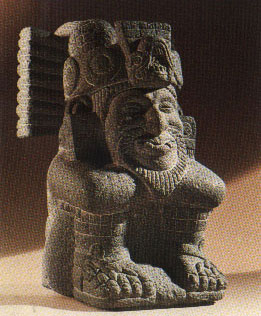Featuring Mythologies 5: Lord of Duality

Via http://jedimaster101.fortunecity.ws/
December 11, 2018
Before the Spanish Conquest, the Aztec Empire was strong and they had their own belief system. They built temples to honor their gods. Quetzalcoatl, Huitzilopochtli, Tezcatlipoca, and Xipe Totec. However, there was one god who they never erected a temple for, Ometecuhtli.
In most polytheism belief systems there is a primordial god, and the Aztecs were no different. Ometecuhtli was the primordial god of the Aztecs. This god was a dual entity, having both represented male and female. His counterpart or other name was Omecihuatl ( “Two Lady” ), and in Nahuatl, he was also called the “Two Lord” or “Lord of Duality”. Due to being a dual entity, his feminine and masculine sides represented the antithetical aspects of nature; like the light and the dark, chaos and order, motion and stillness, and in some versions “good” and “evil”.
Another part of his dual entity persona is that he, alone, is responsible for the birth of four major gods that the Aztecs worshipped. His androgynous sides acted as husband and wife to give birth to the following four major gods; Huitzilopochtli, Quetzalcoatl, Tezcatlipoca, and Xipe Totec. Huitzilopochtli was the god of the sun and war and was considered the patron deity of Tenochtitlan. Quetzalcoatl was the creator of mankind and earth, and often considered the god of wind and rain. Tezcatlipoca was often considered the lord of the nocturnal sky and the co-creator of the universe. Lastly, Xipe Totec was the deity of the agriculture, seasons, goldsmiths, and liberation.
Given Ometecuhtli’s immense power it isn’t surprising that this deity was self-created. Furthering information on him would be that he appeared to have to be adorned with ears of corn and other symbols of fertility.
In other beliefs, he is believed to be responsible for releasing the souls of the infants before and in preparation for human births on earth.
With that being said, here is the interesting part. Ometecuhtli was placed in the 13th heaven, which was the highest plane. He was thought to be the most powerful deity, but because of his placement in the highest realm, the Aztecs did not erect any temples for him. They believed that he was too mighty to be involved in the affairs of the lower Aztec deities. He was, in a sense, disconnected from the other Aztec beings and mortals. However, even with the lack of visual worship, the Aztecs were still believed to have put this mighty being in their thoughts and prayers.
The Aztecs had a strongly built civilization. Their belief system and organization skills were prime examples of their intelligence. Despite this strength, in the year of 1521, the Spanish, led by Hernán Cortés conquered the Aztecs. That was the end of the great Aztec Empire.





















































































































































